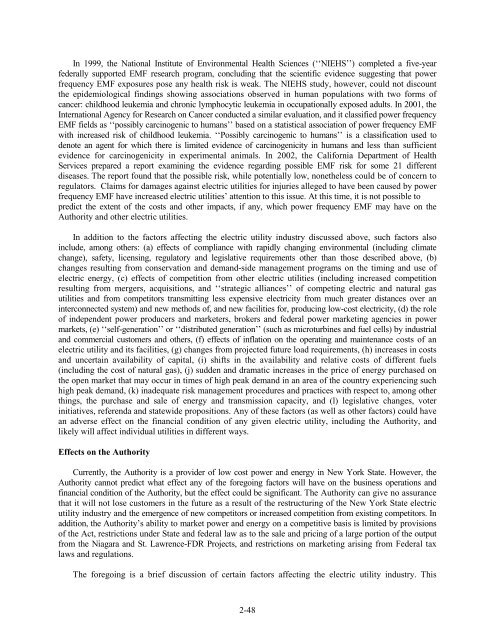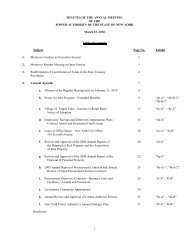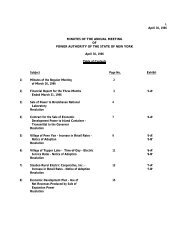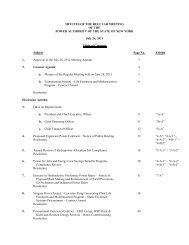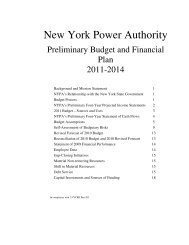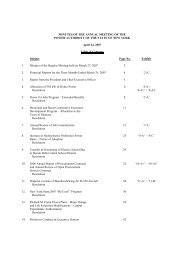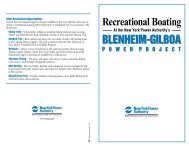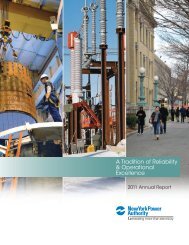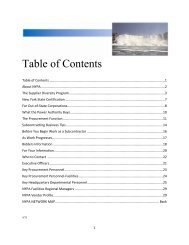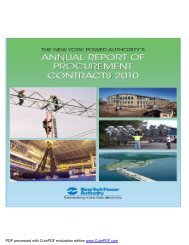July (pdf) - New York Power Authority
July (pdf) - New York Power Authority
July (pdf) - New York Power Authority
Create successful ePaper yourself
Turn your PDF publications into a flip-book with our unique Google optimized e-Paper software.
In 1999, the National Institute of Environmental Health Sciences (‘‘NIEHS’’) completed a five-year<br />
federally supported EMF research program, concluding that the scientific evidence suggesting that power<br />
frequency EMF exposures pose any health risk is weak. The NIEHS study, however, could not discount<br />
the epidemiological findings showing associations observed in human populations with two forms of<br />
cancer: childhood leukemia and chronic lymphocytic leukemia in occupationally exposed adults. In 2001, the<br />
International Agency for Research on Cancer conducted a similar evaluation, and it classified power frequency<br />
EMF fields as ‘‘possibly carcinogenic to humans’’ based on a statistical association of power frequency EMF<br />
with increased risk of childhood leukemia. ‘‘Possibly carcinogenic to humans’’ is a classification used to<br />
denote an agent for which there is limited evidence of carcinogenicity in humans and less than sufficient<br />
evidence for carcinogenicity in experimental animals. In 2002, the California Department of Health<br />
Services prepared a report examining the evidence regarding possible EMF risk for some 21 different<br />
diseases. The report found that the possible risk, while potentially low, nonetheless could be of concern to<br />
regulators. Claims for damages against electric utilities for injuries alleged to have been caused by power<br />
frequency EMF have increased electric utilities’ attention to this issue. At this time, it is not possible to<br />
predict the extent of the costs and other impacts, if any, which power frequency EMF may have on the<br />
<strong>Authority</strong> and other electric utilities.<br />
In addition to the factors affecting the electric utility industry discussed above, such factors also<br />
include, among others: (a) effects of compliance with rapidly changing environmental (including climate<br />
change), safety, licensing, regulatory and legislative requirements other than those described above, (b)<br />
changes resulting from conservation and demand-side management programs on the timing and use of<br />
electric energy, (c) effects of competition from other electric utilities (including increased competition<br />
resulting from mergers, acquisitions, and ‘‘strategic alliances’’ of competing electric and natural gas<br />
utilities and from competitors transmitting less expensive electricity from much greater distances over an<br />
interconnected system) and new methods of, and new facilities for, producing low-cost electricity, (d) the role<br />
of independent power producers and marketers, brokers and federal power marketing agencies in power<br />
markets, (e) ‘‘self-generation’’ or ‘‘distributed generation’’ (such as microturbines and fuel cells) by industrial<br />
and commercial customers and others, (f) effects of inflation on the operating and maintenance costs of an<br />
electric utility and its facilities, (g) changes from projected future load requirements, (h) increases in costs<br />
and uncertain availability of capital, (i) shifts in the availability and relative costs of different fuels<br />
(including the cost of natural gas), (j) sudden and dramatic increases in the price of energy purchased on<br />
the open market that may occur in times of high peak demand in an area of the country experiencing such<br />
high peak demand, (k) inadequate risk management procedures and practices with respect to, among other<br />
things, the purchase and sale of energy and transmission capacity, and (l) legislative changes, voter<br />
initiatives, referenda and statewide propositions. Any of these factors (as well as other factors) could have<br />
an adverse effect on the financial condition of any given electric utility, including the <strong>Authority</strong>, and<br />
likely will affect individual utilities in different ways.<br />
Effects on the <strong>Authority</strong><br />
Currently, the <strong>Authority</strong> is a provider of low cost power and energy in <strong>New</strong> <strong>York</strong> State. However, the<br />
<strong>Authority</strong> cannot predict what effect any of the foregoing factors will have on the business operations and<br />
financial condition of the <strong>Authority</strong>, but the effect could be significant. The <strong>Authority</strong> can give no assurance<br />
that it will not lose customers in the future as a result of the restructuring of the <strong>New</strong> <strong>York</strong> State electric<br />
utility industry and the emergence of new competitors or increased competition from existing competitors. In<br />
addition, the <strong>Authority</strong>’s ability to market power and energy on a competitive basis is limited by provisions<br />
of the Act, restrictions under State and federal law as to the sale and pricing of a large portion of the output<br />
from the Niagara and St. Lawrence-FDR Projects, and restrictions on marketing arising from Federal tax<br />
laws and regulations.<br />
The foregoing is a brief discussion of certain factors affecting the electric utility industry. This<br />
2-48


